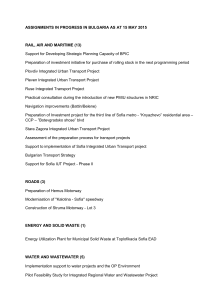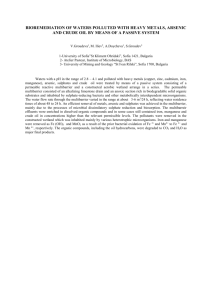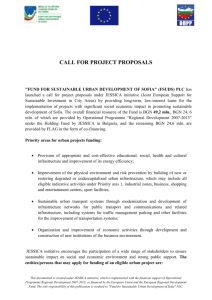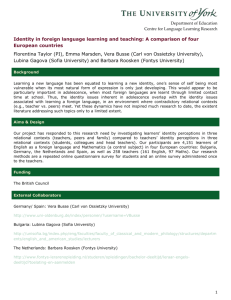Transport and its Environmental Implications in Sofia (1,5Mb)
advertisement
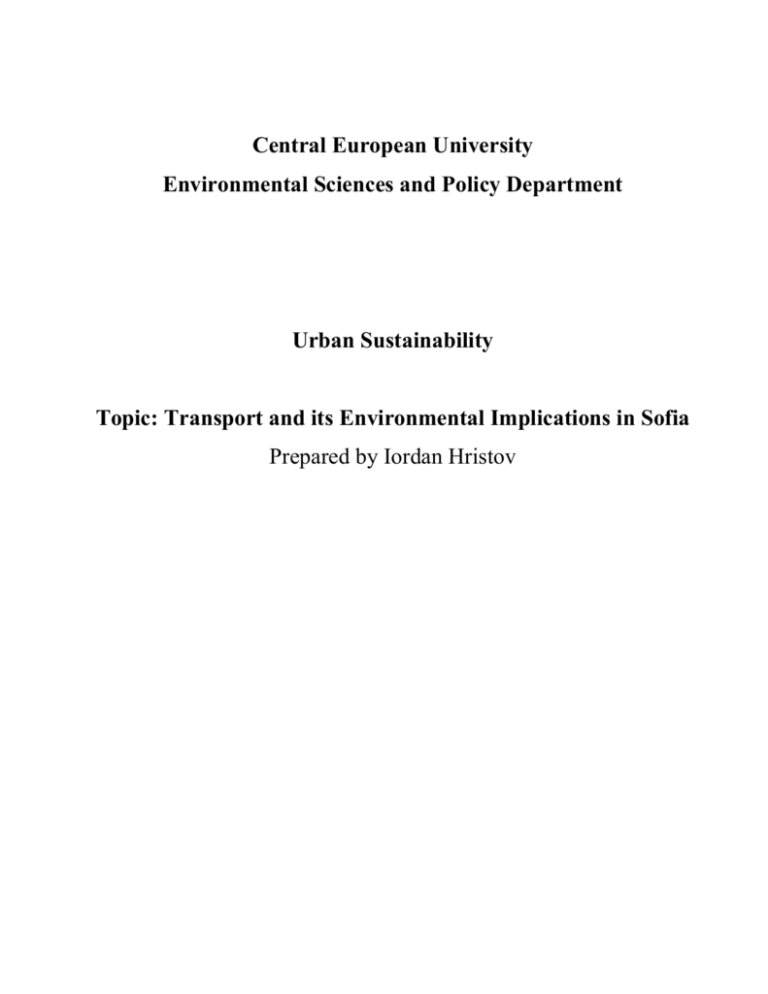
Central European University Environmental Sciences and Policy Department Urban Sustainability Topic: Transport and its Environmental Implications in Sofia Prepared by Iordan Hristov Introduction. More than 75% of the population of the European Union lives in urban areas (EU 2003). To provide easy access of these people to their working places, the EU capitals have well developed transport systems. As capital of Bulgaria - an accession country, Sofia has to be on the level of a European Union capital by 2007. This sets many challenges for transport sector. To identify the sustainability of the transport sector in Sofia, this paper aims to make a comparative analysis of the current situation of the Sofia transport system and the perceptions of the European Conference of Ministers of Transport (ECMT) for sustainable transport. It will first look at the situation of the transport sector in Sofia and then compare it with some best practices. Afterwards, challenges that Sofia has in meeting the requirements of the EU for a well organized transport system will be identified. Based on this, recommendations will be given to reduce the impact of transport on the environment and people. There are two main documents that will be used for review. One of them is the Sofia City Strategy (SCS), which aims to “enhance development of the municipal management system to generate sustainable long-term benefits for its residents” (SCS 2003). The other one is the Bulgarian National Strategy of the Transport Sector (2000). As a guide and a role model for sustainable transport the recommendations of the ECMT for “Implementing Sustainable Urban Transport Policies” (2001) will be used. This paper will argue that not all the possible ways for reducing the negative impacts of transportation in Sofia on the environment and people are taken into consideration in the new Sofia City Strategy. II. Status and trends of the transport sector. As a capital of an accession country, Sofia has to establish a sustainable transport system before it joins the European Union in 2007. According to the European Conference of Ministers of Transport / Council of Ministers (2001:18), a sustainable urban transport strategy involves: “Maximizing public transport use, managing use of private vehicles in urban areas by means of integrated traffic and mobility management, minimizing sprawl through integration of land use and transport planning”. Thus, by controlling car use, they hope to improve the efficiency of the European Union transport systems, enhance their safety and sustainability. To identify the level of sustainability in Sofia, first it is necessary to identify the transport problems and their environmental implications. A survey done in Sofia with residents and business representatives provided feedback for the performance of Sofia Municipality. A significant majority 1 of residents (50 to 82%) identified weaknesses in the street maintenance, parking conditions and street lights (SCS 2003). The fact that the public did not put a high priority on public transport means that a considerable number of the people who were surveyed do not use it. A combination of all these weaknesses and their interrelation sets five major problems of the transport sector in Sofia. These are inadequate level of public transport services, air pollution, congestion, parking and road fatalities. Public transport services Although the public transport is still dominant in Sofia with almost 75% of the vehicles in the city (Table 1), it is gradually losing its position. According to municipal data, buses, trams and trolleys transported 67 percent of commuters to work and only 3 percent traveled by metro in 2000 (Table 1). Average commuting time by public transport in Sofia is 30 minutes - relatively high given the city’s size and according to SCS (2003) it is increasing. Additionally, the increasing prices of the transport services, the irregularity and unreliability in services and conditions of the vehicles will lead people use their cars. Table 1. Public Transport in Sofia, 2002 Passenger trips Public transport Tram Trolleys Bus Metro Private transport Private passenger cars 213 102 428 12 Percentage of trips 67 Number of vehicles, (in thousands) 400 122 650 Percentage of vehicles 420 25 75 3 30 Source of data: Sofia Municipality, 2002 Thus the usage of public transport will declines, which is a prerequisite for increased air pollution and congestion. Air pollution The increased traffic results in high levels of emissions. Estimated 53 % of the population of Sofia is affected by air pollution caused by increased traffic volumes, heat and energy generating enterprises (Sofia Municipal Ecological Program 2001). Furthermore, when the impact of the other sectors was also included in the statistics, it was estimated that 88% of the population in Sofia does not leave in 2 ecologically sound conditions (Sofia Municipal Ecological Program 2001). Some of the main compounds emitted by transport are sulphur dioxide (SO2), carbon dioxide (CO2), carbon monoxide (CO) and nitrogen oxides (NOx). Sulphur and nitrogen are the main ingredients of diesel and petrol fuels. As a result of the combustion process in the engines they form SO2 and NOx. When the SO2 and the NOx contact with water evaporations in the atmosphere they form acid rain. Emissions of CO2 and NOx in Bulgaria th.tons CO2 NOx Emissions of CO and SOx in Bulgaria th.tons 65000 240 60000 230 th.tons 1400 1200 220 55000 50000 190 40000 180 1997 1998 1999 2000 2001 CO 800 200 45000 SOx 1000 210 600 2002 400 1997 1998 1999 2000 2001 2002 Fig 1. Emissions of CO2 and NOx in Bulgaria (Source of data: National Statistical Institute 2003). year Fig 2. Emissions of CO and SOx in Bulgaria (Source of data: National Statistical Institute 2003). The reduction of the sulphur dioxide (SO2) and nitrogen oxides (NOx) emissions in the last five years (see fig.1 and fig.2) can be explained with the introduction of phasing-out schemes for leaded petrol in 1998 and the introduction of EURO diesel fuel with a lower content of sulphur. Carbon dioxide (CO2) is a greenhouse gas. According to ECMT (1999), 25% of the CO2 emissions in the atmosphere are from the transport sector. Carbon monoxide is a toxic gas and on a local level, in short term, it can cause severe health problems. One of the reason for the increase in the emissions of CO is the growing number of old cars imported from Western Europe, which do not have full and clean combustion process in their engines. Most of these cars do not have catalytic converters or if they have, the converters do not function. Another reason for the increasing emissions of CO is the comparatively short distances that people travel with their cars. The average distance from the suburbs to the city center is around 10 km. As a result, the engines and catalytic converters cannot reach their working temperature and combustion and oxidizing processes in the engine and converter, respectively, are not full. Thus, CO is emitted. Although there is a severe decline in the emissions of CO21 (see fig.1) over the last five years, there is an increase in the 1 the data refers for industrial combustible and production processes, road transport, agriculture and households the whole country. 3 concentrations of carbon monoxide (CO) (see fig.2). The increasing trends of the CO emissions can be considered for the major pollution problem from transport because of the high number of old vehicle. Congestion Congestion is another significant problem of the transport in Sofia. Some of the reasons for the high level of congestion are the increasing number of cars. Totally, over the last decade, traffic in Sofia has increased by 35% due to increased personal mobility, growth in freight and passenger traffic (SCS 2003). The statistics show that the annual growth rates for private automobiles in the capital is six to eight percent (SCS 2003). Problems with parking in the city Another result of the increased traffic in Sofia is shortage of parking, which is of growing concern for both residents and the business community (SCS 2003). One of the biggest problems with parking are the “monuments” – cars that are parked somewhere in the city and “forgotten” there. These are usually old cars or cars after an accident, whose owners do not have the funds to repair them or just do not have the will to do so. Increases in the number of parked cars in the central area and weak enforcement of fees for parking along city streets and sidewalks further contributes to traffic jams and parking problems (SCS 2003). The results of the traffic jams are high emissions. Road fatalities Road safety is another issue that Bulgaria should set as a priority. According to statistics, Sofia has one of the highest rates of road fatalities in Europe. From fig.3 one can see that the trends in the last four years hardly changed. This suggests, that the government and the municipalities do not consider the problem as a priority. Fig 3. Road fatalities trends for Bulgaria. (OECD 2003) 4 III. Measures to improve transport in Sofia. 1. Best practices One of the cities that could be a role model for Sofia for a well-managed transport system is London. It was one of the most polluted cities in the last century. The lessons that the city administrations have learned over the years can be considered as driving forces for improving their performance in the urban transport planning. The London Planning Advisory Committee plans to reduce car use by 50% in Central London and 10% in the outskirts of the city by 2005 (ECMT/OECD 1999). The measures to reduce the car use in London target all the issues related to transport management at different levels. At the level of the National Government, the United Kingdom has taken a step to integrate the environmental, transport and spatial planning departments into one organization – Department of Environment, Transport and the Regions (ECMT/CM 2001). Thus, all the interested parties will be able to take part in the city planning. Through a complex approach and coordination among the parties in the Department, the objectives will be fulfilled more easily and thoroughly. Another measure was the introduction of “fuel price escalator” in 1990, which was also done at the same governmental level. Furthermore, stringent parking policies and road pricing system were introduced in London to limit the number of cars in the city center. In addition to the car use limitations, the administration of London has improved its public transport services (ECMT/CM 2001). This offer of alternatives is a necessary positive incentive for people to leave their cars. Thus, the transport system of London is one of the most sustainable in Europe. 2. Strategies in place The current strategies in place include the Sofia City Strategy (2003) and the Bulgarian National Strategy of the Transport Sector (2000). To solve the transport problems of the country and reach a level of sustainability in transportation the government prepared the Bulgarian National Strategy of the Transport Sector (2000). Some of the key objectives with regard to environmental aspects are the following: - renewal of the bus fleet and use of new environmentally friendly motors; - promoting the use of combined transport; - improving the environmental performance of transport infrastructure plans and projects; - enhancing the use of cleaner fuels. However, these measures are on a national level and there is no specific chapter treating the environmental problems of the urban transport. The specific problems for Sofia are treated in the Sofia City Strategy. Its main goal is to “enhance development of the municipal management system 5 to generate sustainable long-term benefits for its residents” (SCS 2003). To solve the problems of the transport with regards to environment, the Sofia Municipality sets the following priorities for action (SCS 2003): - to improve the public transport services by optimizing its use, increasing its reliability and regularity and reducing the commuting time; - to improve and further expand the subway; - to expand the pedestrian and bicycle zones; - to improve access to parking and decrease traffic congestion in the city center; - to enhance the existing network of pedestrian zones; - to create a balanced spatial structure that enhances opportunities for economic growth and social diversity; - to improve the quality of life in existing residential areas; - to develop market-based mechanisms to enhance the scope and quality of urban transport; - to continue to strengthen the financial self-reliance of the Holding company and its six subsidiaries; - to collaborate with external financiers to further the companies’ business practices and increase use of private sector practices; - to ensure accessibility and sustainable use of environmental resources. General comparison of the Bulgarian National Strategy of the Transport Sector (2000) and the Sofia City Strategy (2003) with the definition of the ECMT for sustainable urban transport strategy, shows that in its strategies Bulgaria has covered all of the issues addressed in it by the ECMT – maximizing the public transport use, car use control and integrated transport planning (ECMT 2001). However, this is not confirmed by the trends in Sofia as it was shown in section two. Planned projects and priorities for action To address the trends, the Program Action Matrix for the Sofia Strategy (see Annex 1), has targeted three major issues – improvement of the public transport system and services, improvement of parking conditions and reduction of traffic congestion. The improvement of the transport system includes further expansion of Sofia’s subway system plans to commute up to 40% of the residents (SCS 2003). Furthermore, efforts that are underway to improve the transport services include reconstruction of tramlines, renovation of street lighting (SCS 2003). Adequate planning for roads and transport infrastructure is also underway to address the demands of the growing economy and 6 increased city congestion and transportation needs (SCS 2003). Constructing multistory public and private parking facilities will improve the parking conditions in Sofia (SCS 2003). According to the SCS (2003), the congestion is going to be solved by restricting inner city blocks to pedestrians and service vehicles and implementing traffic management systems such as green wave. However, the measures listed in The Program Action Matrix do no treat all the problems of the urban transport and the Municipality will not be able to solve all the challenges the city has. Some of these are the problems with the parked “monuments”, the large number of old vehicles in the city and the road fatalities. To cope with these and others, the Sofia Municipality has to do a better identification of challenges for the transport and take the necessary measures. IV. Challenges and recommendations for the transport in Sofia. As a future EU capital, Sofia has to cope not only with the city specific challenges, but also to meet the EU requirements. One of the challenges that the urban transport in Europe will have in the coming years will be to “meet the demand for accessibility for people, including people with reduced mobility and goods, while at the same time minimizing the impacts on the environment while safeguarding the quality of life” (EU 2003). To do that the city administration should have enough funds, which can be considered for one of the biggest challenges in attaining sustainable transportation. All the elements contributing for reaching a level of sustainability should be controlled simultaneously (ECMT 2003). These include control on car use, improvement of the public transport services and integrated policy measures. The recommendations of the ECMT for implementing sustainable urban transport policies could play a major role in the Sofia city planning. Some of the policy recommendations of the ECMT concerning the urban transport could also be relevant to Sofia. According to ECMT (2003), a considerable role in the city planning could have the public. Since the transport system addresses the need of the society, its participation in the city planning could increase the effectiveness of the transport system. That is why, further involvement of the public in should be done to reach the level of sustainability of the EU capitals. Public transport The level of public transport services is probably the factor that has the biggest role in improving the sustainability of the transport in Sofia. One of the biggest challenges for the public transport is the lack of funds. The recommendations of ECMT (2001) for improving the financial situation of the transport systems include implementation of pricing initiatives (e.g., road or congestion pricing, 7 parking fines, etc.). Currently, the use of fines is the most widely applied method for tax collection in Sofia. The congestion pricing might not be appropriate for the city, because of the low level of overall financial certainty of the residents. According to ECMT (2001) allocation of funding among different travel modes could also help for development of all the modes simultaneously. Since the Metro is the fastest developing traffic mode some of the revenues could be allocated from it. The other option is make use of different pricing initiatives. “Fresh” inflow of capital could also come from privatizing the Municipal Transport Company. To make profit the private owners will make sure they fulfill the requirements of the public. Thus will be provided adequate services and low prices, which will stimulate the public to use the public transport. This will reduce the congestion in the city, the air pollution and road fatalities. Air pollution Air pollution is another problem that is very challenging. The large numbers of old cars in the city including the vehicles of the public transport are major issues. Positive incentives and a variety of economic tools should be used to promote changing of the car park. It should be forbidden the import of old cars from the Western European countries. Furthermore, the control on car use can be targeted in some ways. Measures to control the car ownership, measures to control the parking of vehicles in the urban area and regulatory, physical and fiscal control on moving vehicles could be undertaken to limit the car use (ECMT 2001). In addition to provide alternatives, further stimulation of the residents to use public transport should be developed. To address the issue of air pollution, ECMT recommends full integration of air quality, greenhouse gas, noise and other environmental targets into transport and land-use policies (ECMT 2001). Congestion The issue is of primary importance if we have in mind the increasing number of private vehicles. To address the issue, ECMT recommends all modes of travel to be considered, and particularly the environmentally sustainable modes. Furthermore, ECMT (2001) also promotes walking and cycling in urban areas. Having in mind the short distances that people in Sofia travel, further studies and promotion of cycling and walking in the urban area should be done. Although one of the objectives in the Sofia City strategy is to expand the pedestrian and bicycle zones, during this study could not be found any data for the number of people cycling or walking in the city center and the average length of their trips. Data concerning the impact of cycling and walking on the traffic congestion and 8 emission of contaminants also could not be found. In regards to this, improving of data collection is another recommendation of the ECMT (2001). Problems with parking in the city It was already mentioned that parking in Sofia is of considerable importance. One of the measures that the SCS has included in its Action Plan Matrix is the creation of private parking facilities. However, according to the ECMT (2001), one of the challenges for the city municipalities in Europe are the private parking facilities. By giving the control to the business the city administration loses control over this measure for car use control. It cannot integrate it in the overall policy measures and city planning. By providing the opportunities for building private parking facilities, the Sofia administration loses control over one of the elements to control car use. City specific are the “car monuments”. To improve the parking conditions in regards to financial incentives could be introduced for removing the old cars and emptying parking spaces. Metal, plastic and other industrial plants could buy and recycle the old cars. Thus the city administration will be pleased that there are more places for parking and the car owners will be pleased that somebody has taken care of their old cars. One of the representatives of a famous car brand in Bulgaria buys old cars and gives a discount in purchasing a new car from their company. This can be considered a good practice and could be implemented on a larger scale. The National Government could also support such kind of initiatives. Road fatalities Whatever improvements of the transport sector is done, the life of the people will always be the most important issue the city administration should prioritize. A considerable challenge here is the low number of instruction classes for beginners in driving. As a result, many drivers in the streets do not have the necessary qualifications and create prerequisites for accidents. Increase in the number of classes for beginners could help reduce the fatalities on the roads. Another reasons for the high number of road fatalities can be the high number of personal cars. Further limitations should be established. This will also result in lower amount of emissions, congestion and increased used of public transport. 9 Conclusion To have a sustainable transportation, Sofia has to take a complex perspective and incorporate the environmental and transport policies with the urban planning. The Program Action Matrix of the Sofia City Strategy includes measures such as improving access to parking, decreasing traffic congestion, improving the efficiency of the subway and strengthening the financial position of the city’s public transport company - SKGT. These measures address the priorities of the city, but the trends show that not all possible ways to reduce the impact of transport on the environment and people are taken into consideration. If the current trends remain at the same level, Sofia will not be able to meet the requirements of the European Union. To do that, the recommendations of the ECMT for a sustainable urban transport can be used. Thus, the transport in Sofia will be improved and it will become a sustainable capital with maximized public transport use, well managed use of private vehicles and well integrated traffic and mobility management. References European Conference of Ministers of Transport / Council of ministers. (ECMT/CM) 2001. CEMT/CM (2001)12 Implementing Sustainable Urban Transport policies. "Key Messages for Governments"., 5., Lisbon. European Conference of Ministers of Transport (ECMT/ OECD). 2003. “Short term trends survey: Second quarter”. [consulted on January. 19th, 2004] http://www1.oecd.org/cem/stat/conjonct/conjpdf/BGR2Q.pdf European Union 2004, [consulted on January. 19th, 2004], http://www.europa.eu.int/comm/energy_transport/en/cut_en.html ECMT/OECD, 1999, “Making the links: Car Use and Traffic management measures in the Policy Package”, [consulted on January. 19th, 2004] http://www1.oecd.org/cem/UrbTrav/Workshops/Carscities/May.pdf National Statistical Institute, 2003, [consulted on January. 19th, 2004] www.nsi.bg Republic of Bulgaria, National Strategy: Transport Sector, Ministry of Transport And Communications, June 2000, [consulted on January. 19th, 2004] http://www.mt.government.bg/en/Transport/Politics/national_strategy.htm Sofia Municipality., Sofia City Strategy, (SCS) 2003, Tip-Top Press Ltd., Sofia. 10 Annex 1. Program Action Matrix for the Sofia City Strategy 11
